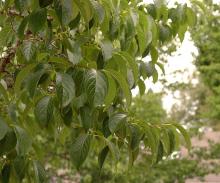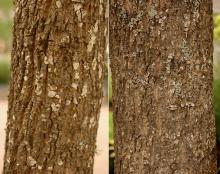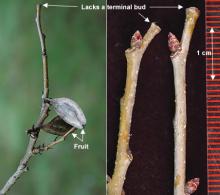Eucommia ulmoides
Common name:
Hardy Rubber Tree
Gutta-percha Tree
Pronunciation:
u-KOM-i-a ul-MOY-dez
Family:
Eucommiaceae
Genus:
Type:
Broadleaf
Native to (or naturalized in) Oregon:
No
- Broadleaf deciduous tree, 40-60 ft (12-18 m) high and 30-50 ft wide (9-15 m), rounded to broad spreading at maturity. Leaves alternate, simple, 8-15 cm long and about half as wide, elliptic, ovate, to oblong-ovate, tip acuminate, margin serrate, glossy dark green, somewhat rugose (wrinkled) when mature, when the blade is torn it exhibits a rubbery latex (see below). Dioecious - male and female trees, flowers small, greenish-brown, inconspicuous. Fruit flat, waxy surface, oval-oblong, about 4 cm long, a notch at the apex, 1-seeded, resembling a large, fleshy elm fruit.
- Sun. Free of pests.
- Hardy to USDA Zone (4)5 Native to central China, but unknown in the wild, where its bark is peeled back, dried, and the inner bark separated, ground. An extract of the bark is used with other plants to treat various disorders.
- "If a leaf is torn gently in half, the two halves eased apart, and then the stalked half held, the detached lower half will hang seemingly unconnected, but it is in fact attached by fine strands of latex almost invisible to the naked eye". The Hiller Manual of Trees & Shrubs, Pocket Edition, 1998, p. 202.
- Although sometimes called the Gutta-percha tree, the "true" Gutta-percha trees are in genus Palaquium in the family Sapotaceae.
- ulmoides: like Ulmus, Elm.
- Corvallis: two trees each at 1720 Beca and also across the street at 1721 Beca.












